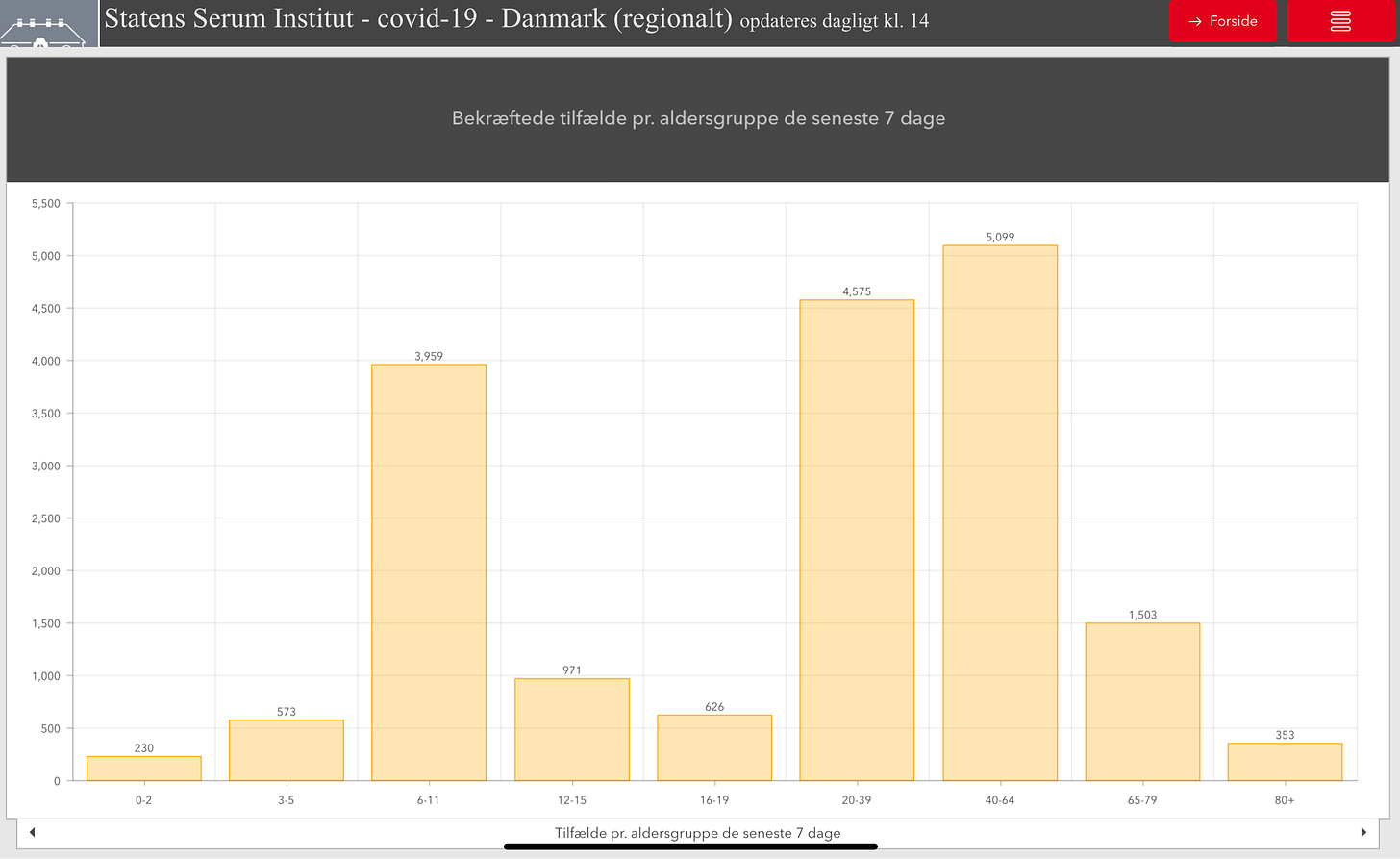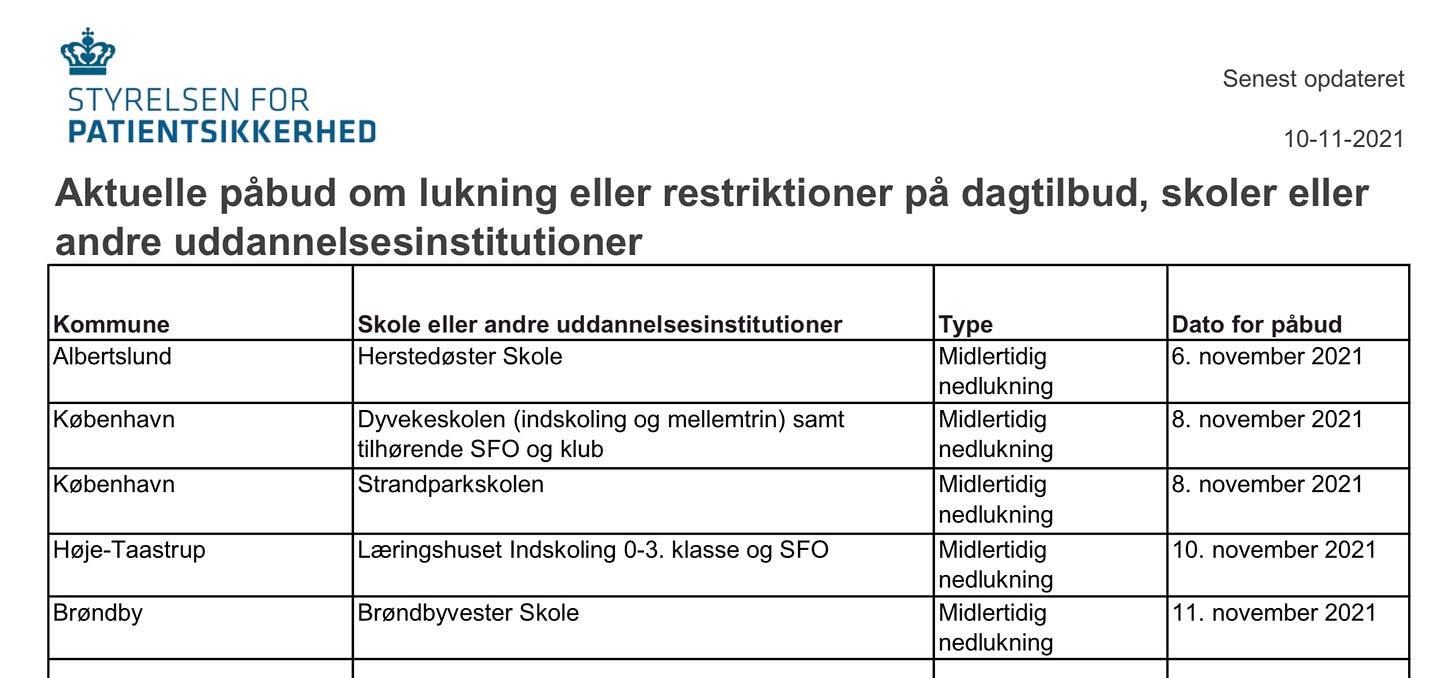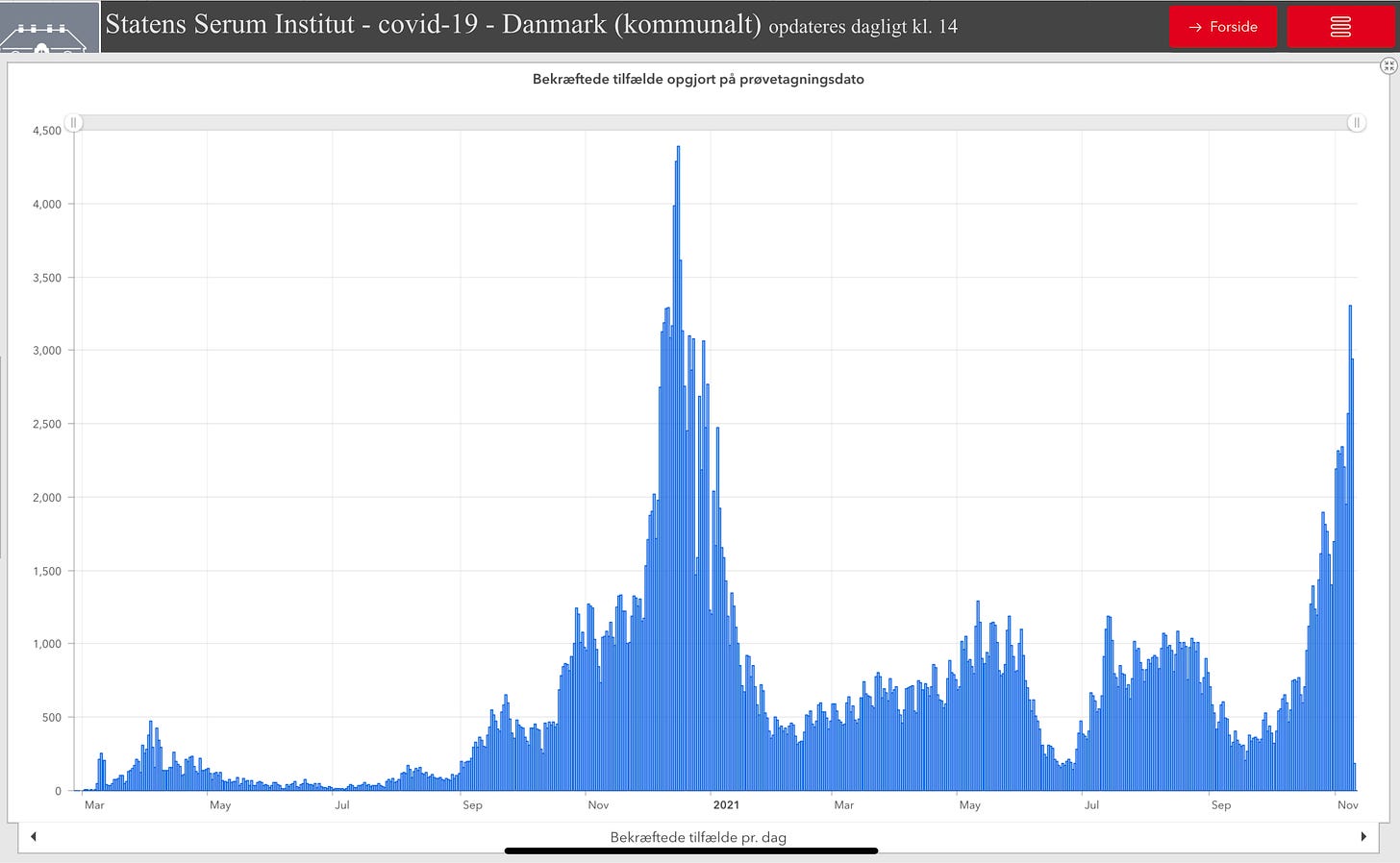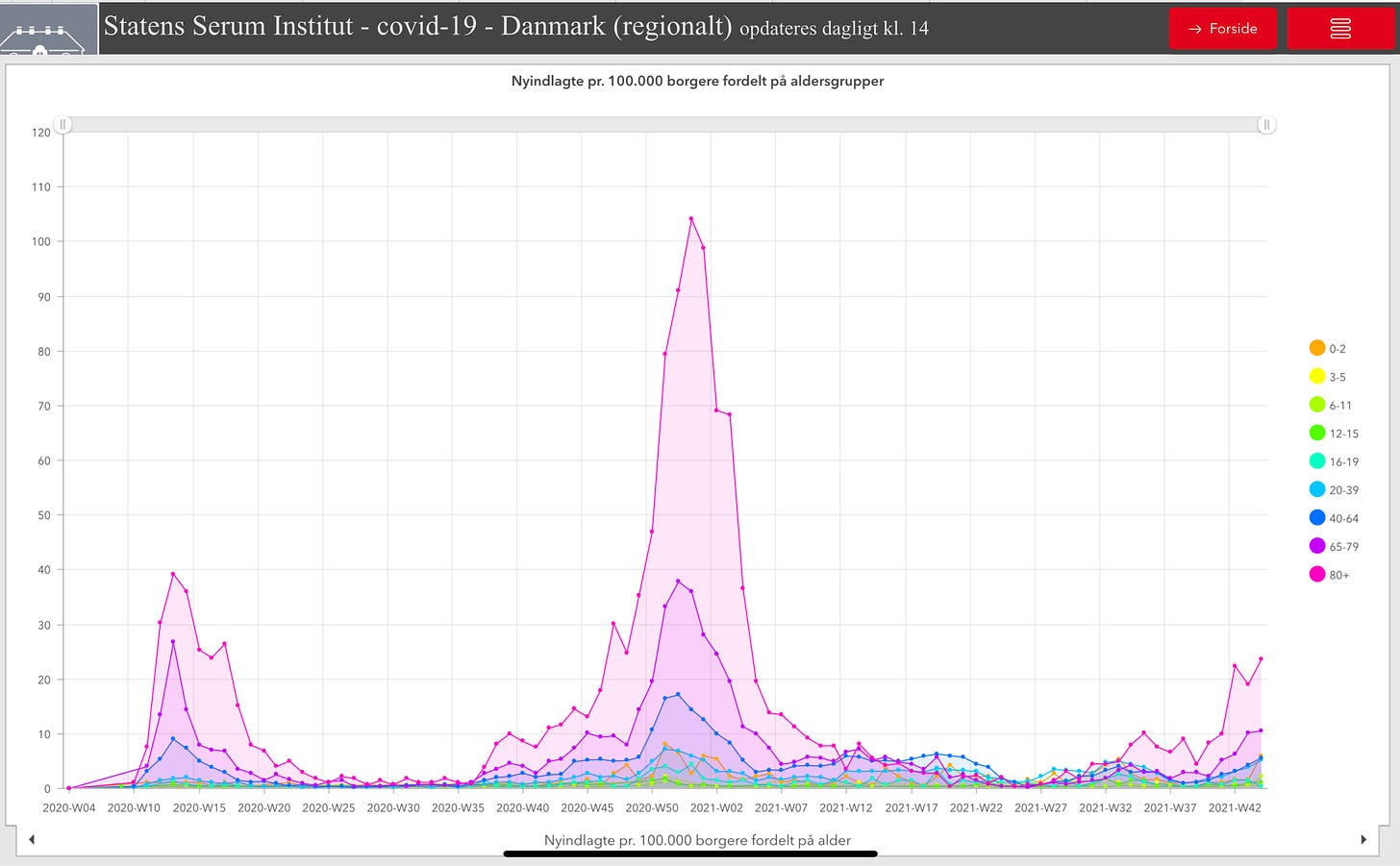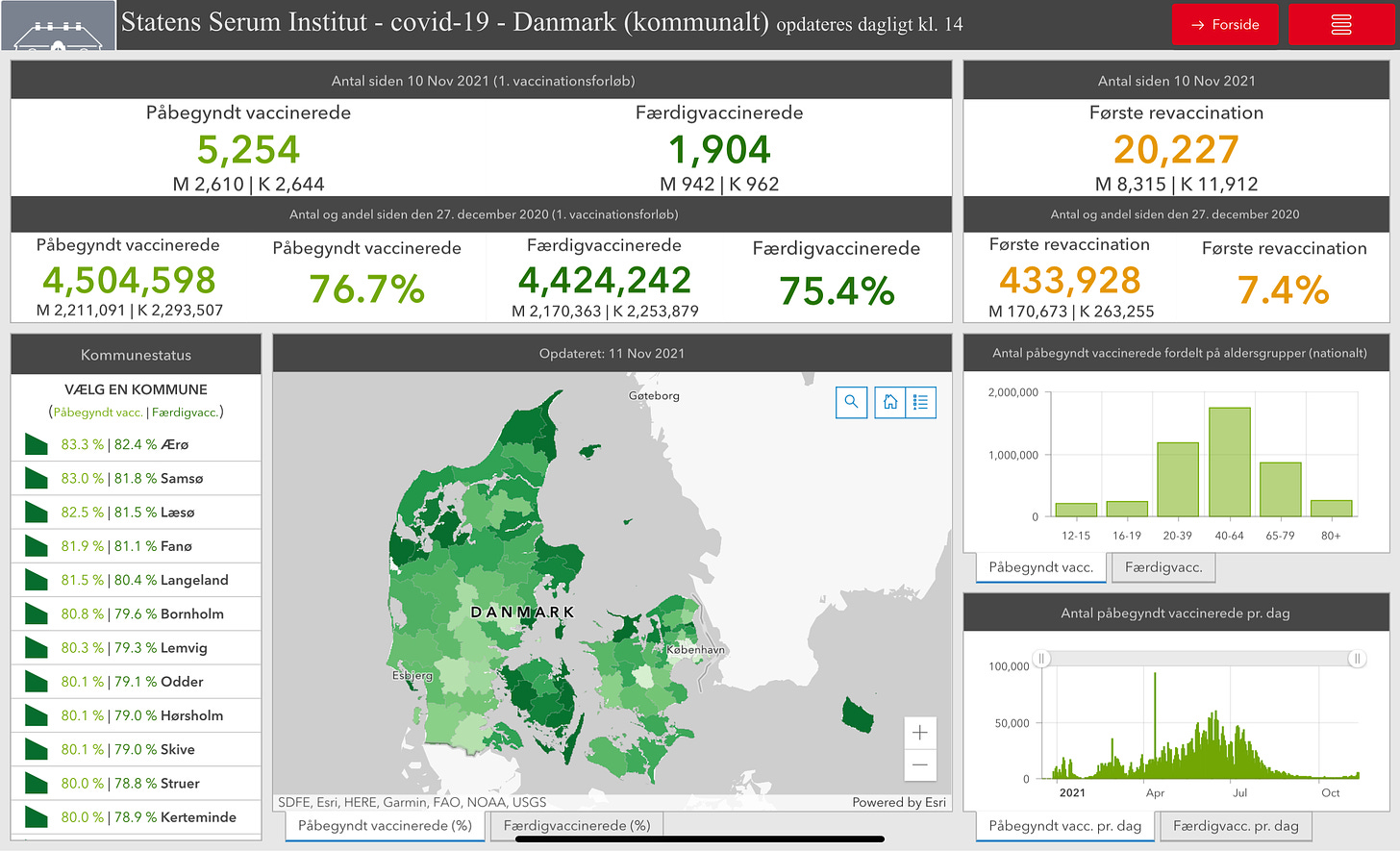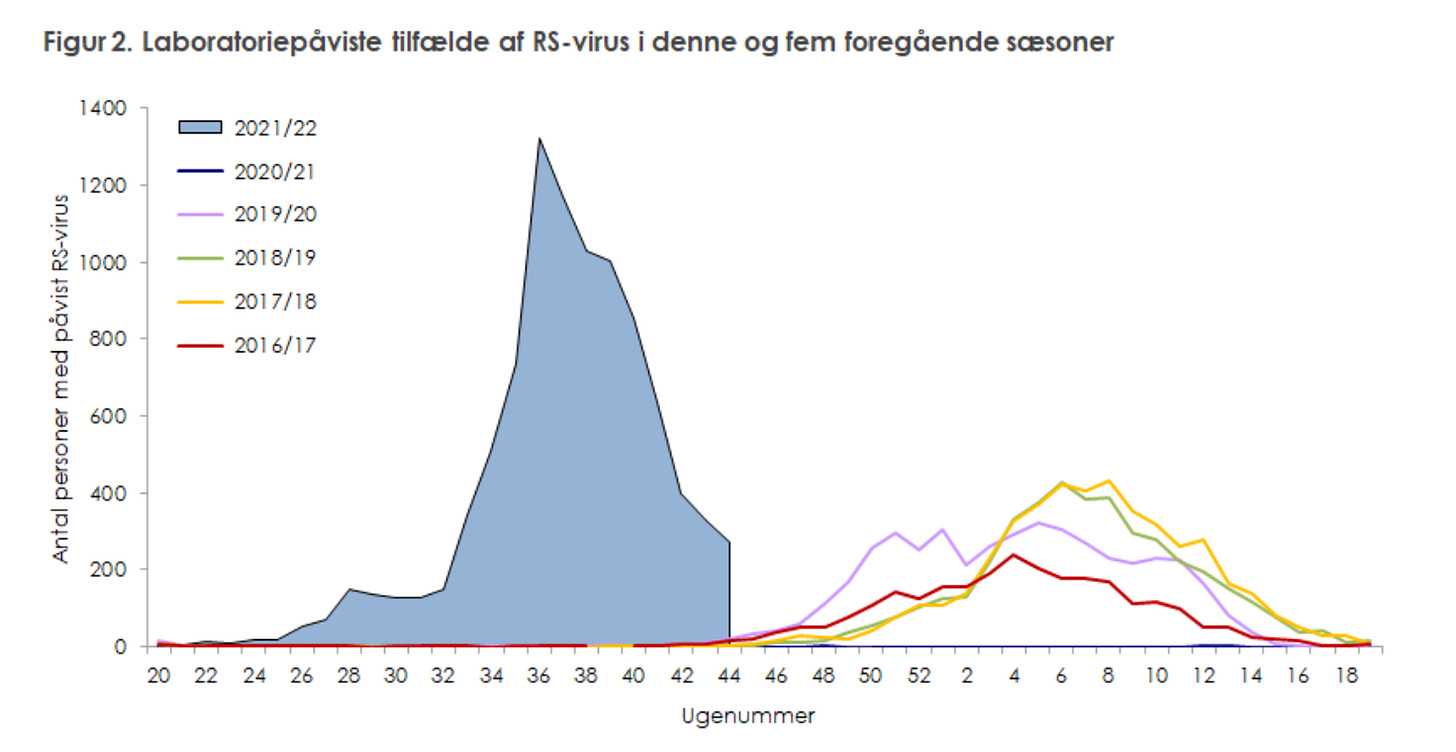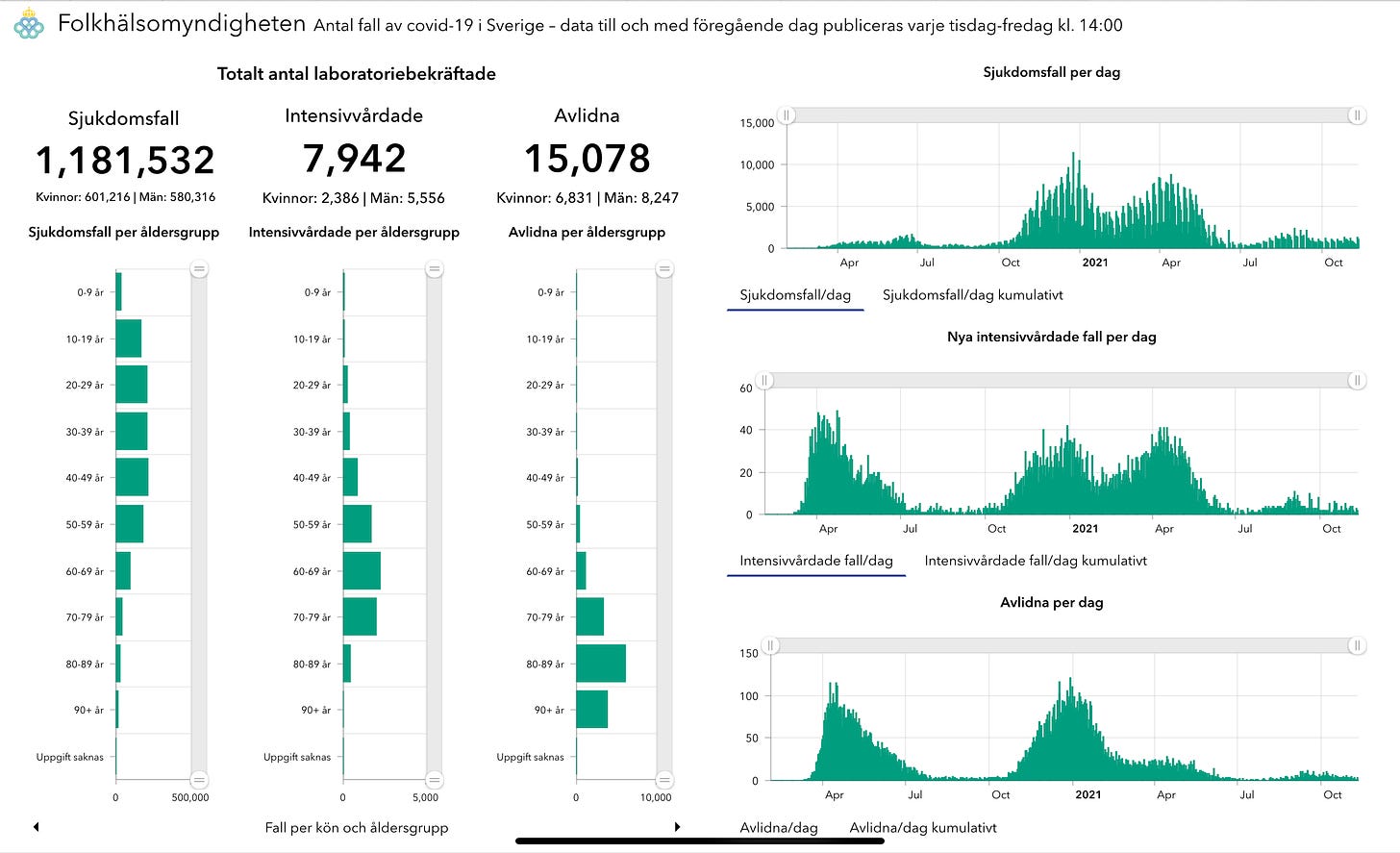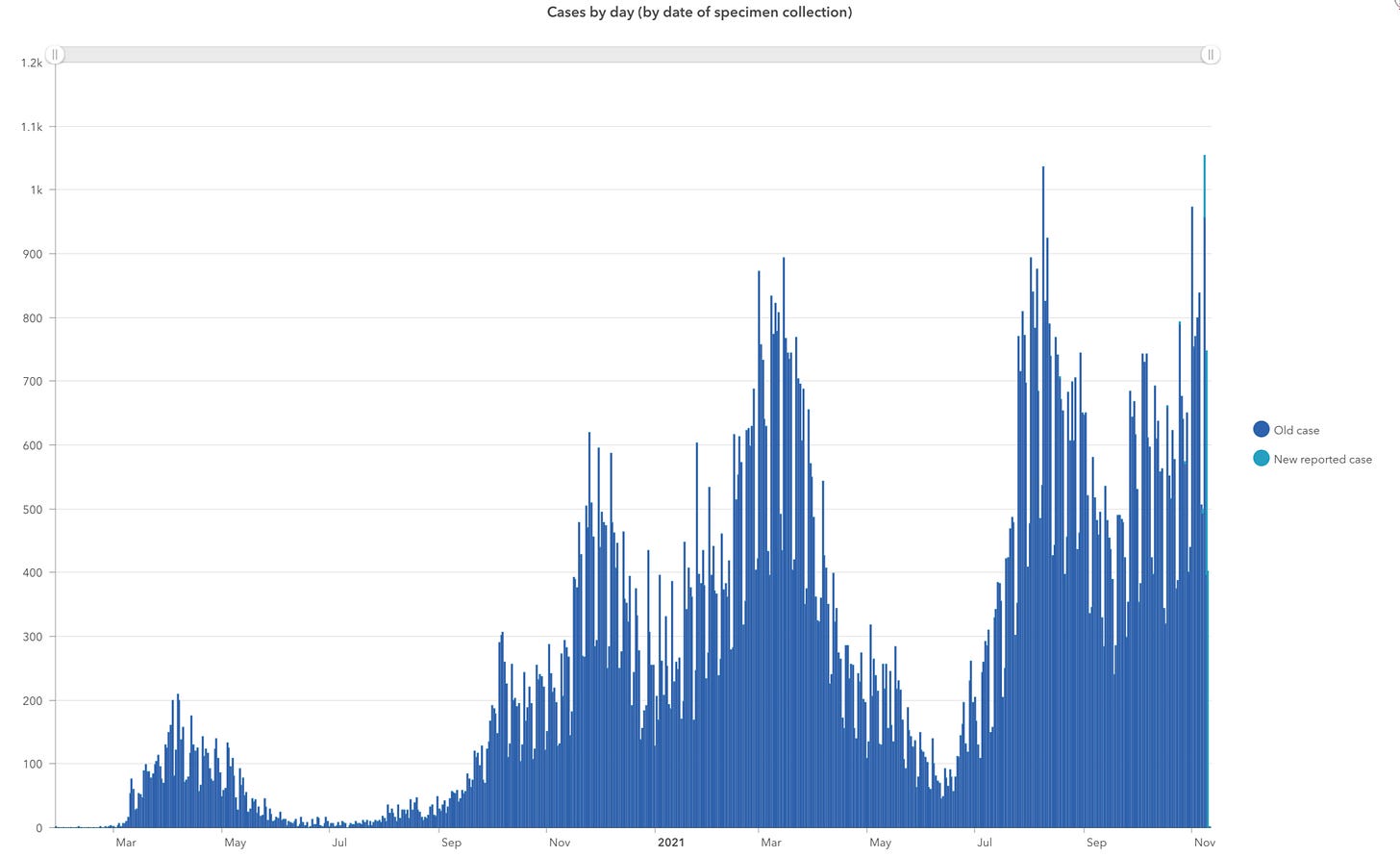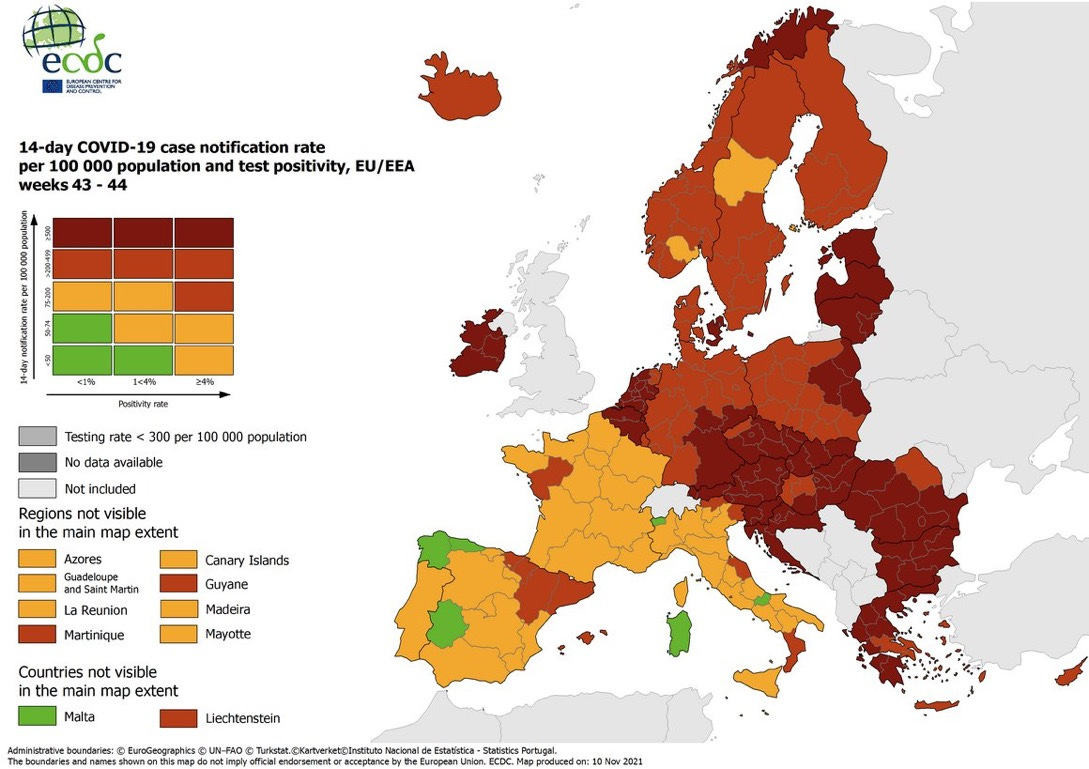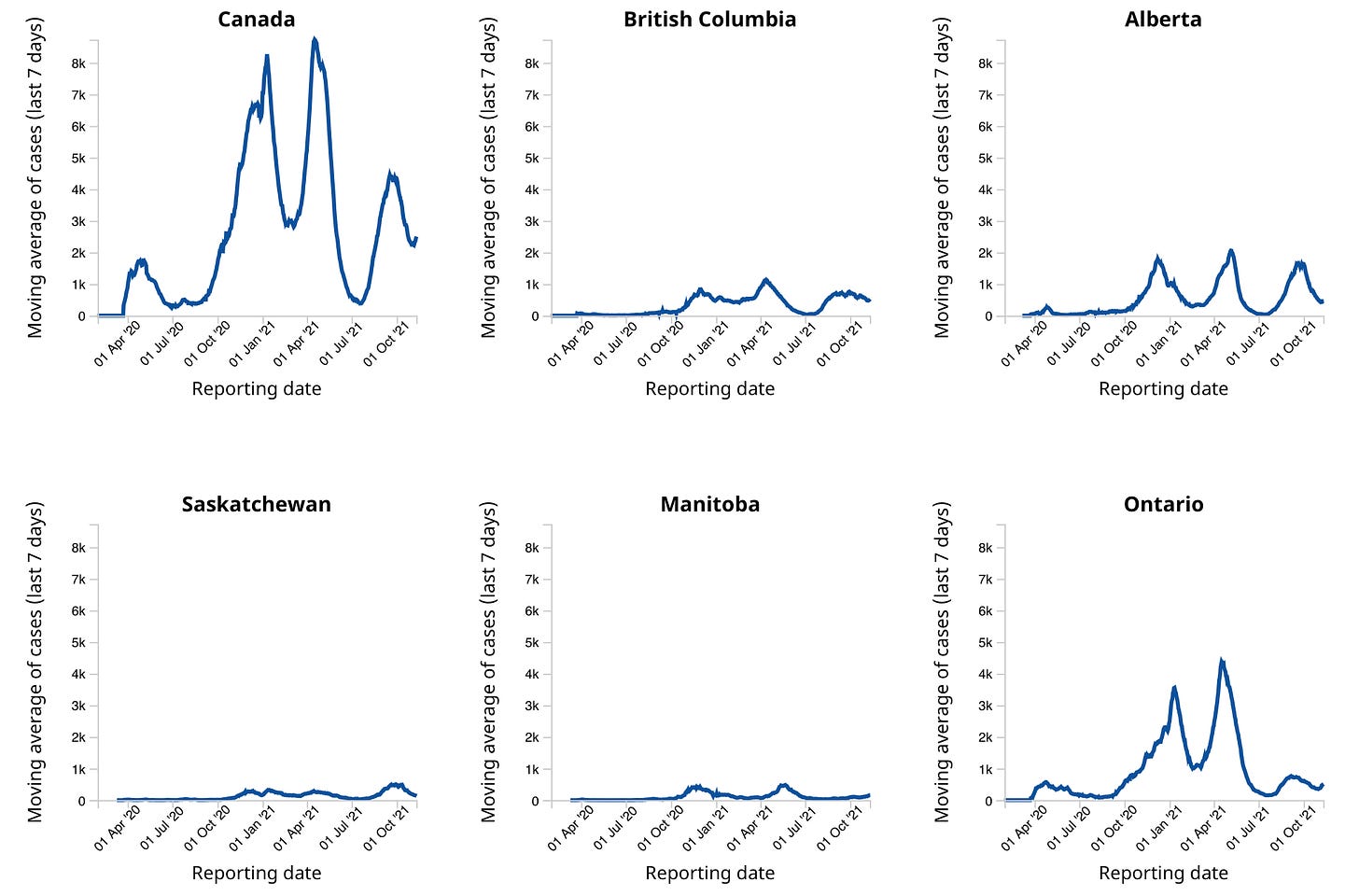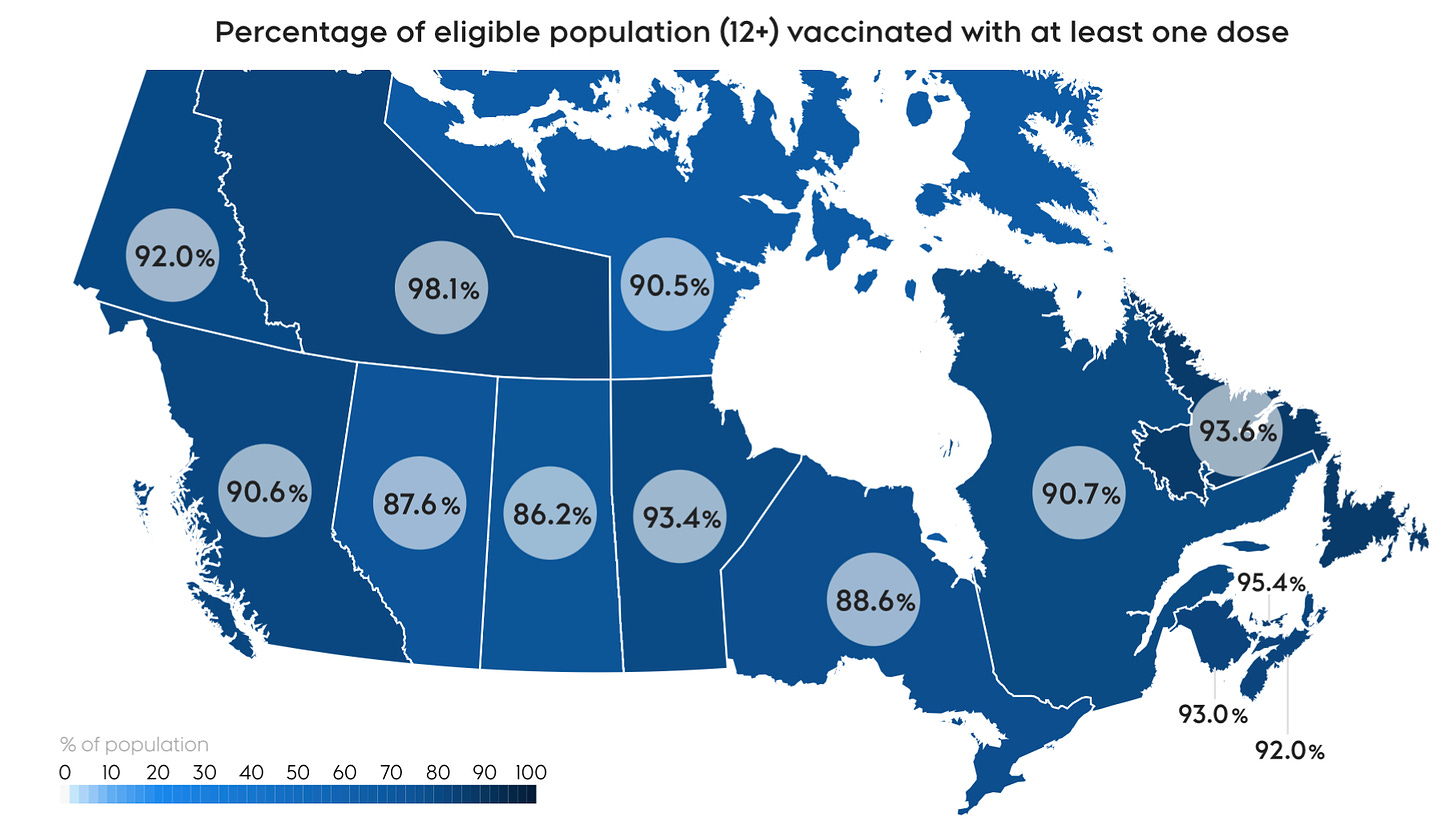🇩🇰
The coronavirus epidemic in Denmark “is still going the wrong way” according to the latest weekly assessment from the Staten Serum Institut. It is also noting an alarming trend, as infections rates are now highest among young people who either have not been vaccinated or cannot yet be vaccinated.
The institut says infections continue to rise, with cases increasing by 34% last week compared to the week before. The national COVID incidence rate also shot up week to week, going from 148 per 100,000 residents to 273. Most concerning is that despite a major increase in the number of daily coronavirus tests, the positivity percentage also continues to rise, going from 2.3% to 2.5% from one week to the next.
Ward Doctor Rebecca Legarth:
“The epidemic is still growing across the country. It is still highest in the Capital Region, but the growth in infection rates in the other regions is now above the growth rate in the Capital Region.”
The highest infection rates were among unvaccinated kids 12 to 15 years old, followed by children 6 to 11 years old. The SSI says the trend is evident in the high number of school outbreaks and infections among primary school staff as well.
“If you only look at the part of the 12-15-year-olds who have not yet been vaccinated, then they actually have the highest infection rate and thus an incidence that is slightly higher than for the 6-11-year-olds.”
According to SSI data, there have been almost 4,000 COVID cases among children aged 6 to 11 years old in the last seven days alone.
The institut says the data is clear, vaccines protect against serious illness and hospitalization. Its latest report shows unvaccinated people over the age of 12 are 3.2 times more likely to become infected and have hospitalization rates almost five times those of a vaccinated person.
-
The Danish Agency for Patient Safety has closed classes in another two schools in the last 48 hours “due to major outbreaks.” The agency ordered students home in grades 4 through 9 at Brøndbyvester School. Classes will remain closed there until at least November 17. It has also closed classes at Læringshuset in Høje-Taastrup Kommune until at least November 16.
That makes a total of five schools in the last week to have a number of classes ordered to go home for a week or so due to COVID outbreaks.
-
As infections rip through the population of school -age children the Danish National Health Board is reminding parents of the COVID guidelines for young kids.
The health board says only an infected person is required to go into isolation. Instead, kids considered close contacts should get a series of tests in the first week after being exposed to an infected person. The guidelines in full are below.
Deputy Director of the National Board of Health Helene Probst:
“The guidelines have been prepared so that there are as few interruptions for children and young people as possible. It is important not to under or over-implement them. It has major consequences for children's mental health with the closures of day care centers and schools, and for parents who have had to stay home from work. Therefore, it is only in special situations that schools are closed.”
Probst emphasizes that it is “absolutely crucial” for children to stay home when they are sick so as to prevent any kind of infection spread.
The Guidelines
For children in primary school and daycare who are close contacts of an infected person.
Children who are not vaccinated or who have not had a recent infection
Get a COVID test (rapid or PCR) as soon as possible.
Follow it up with a PCR test on days 4 and 6 after last contact.
In the event of a positive result, children must isolate at home immediately.
Children with symptoms must stay home.
Children who are not symptomatic can go to daycare or school during the testing period.
Children who have been vaccinated (12 years old and older) or who have had a recent infection who are close contacts with an infected person.
Get a PCR test on days 4 and 6 after last contact.
In the event of a positive result children must isolate at home immediately.
Children with symptoms must stay home.
Children who are not symptomatic can go to daycare or school during the testing period.
Children under 3 years old who are a close contact of a infected person.
Children who are not symptomatic can go to daycare as normal.
Children with symptoms must stay home.
Only children who have symptoms should get tested.
In the event of positive test results, the child should isolate at home immediately.
Children in close contact with an infected family member
Get a PCR test on days 4 and 6 after last contact.
If the child is unvaccinated or has not had a recent previous infection, they should isolate until their second PCR test comes back negative.
-
Take today’s numbers with a grain of salt. The Staten Serum Institut says a technical problem means data was only processed for 11 of the last 24 hour reporting period. Today’s numbers will be much lower than they should be, and tomorrow’s numbers, which will cover 37 hours, is going to be disproportionately high.
That said, Denmark is reporting 2,132 COVID infections and four coronavirus deaths over just 11 of the previous 24 hours. Yesterday it logged 3,017 new corona cases, the highest number of daily infections since December 23, 2020.
There were 205,998 total corona tests yesterday, of which 105,557 were PCR tests equaling a 2.01% positivity percentage.
-
As of today, PCR COVID tests require booking an appointment in advance in all five of Denmark’s healthcare regions. PCR testing centers will no longer take walk-ins. As infections rise once again, testing centers across the country have been dealing with long line-ups. In order to keep things moving without having too many people lined up, the system is returning to work by appointment only.
In order to make an appointment for a COVID test, just go to www.coronaprover.dk
It is important to note that rapid testing sites do not require an appointment.
-
As testing numbers shoot upward, Denmark’s Ministry of Health is noting an odd trend. It says since week 41 the number of vaccinated people getting tested for COVID continues to increase while fewer unvaccinated people are showing up at test centers. The ministry is urging everyone, regardless of vaccination status, to go get tested if they have symptoms. It says testing is an important tool to curb infection spread.
-
COVID hospitalizations (307) dropped (-12) while the number of infected people in an ICU (41) edged upward (+2) and of those the number on a ventilator (24) crept up as well (+1).
-
On the vaccination effort, the increase in first doses administered continues with 5,254 done yesterday, the highest in many weeks. There were 27,385 total vaccinations yesterday; booster doses remain the lion’s share.
To date, 76.7% of the total population has had one vaccine dose, 75.4% have had two, and 7.4% have had a booster shot.
-
A sub-strain of the Delta variant called AY.4.2 does not show any increased resistance to mRNA vaccines currently in use. Denmark’s Staten Serum Institut with the good news this week after successfully cultivating the sub-strain in a secure facility, the first agency in the world to do so, and then testing it against vaccine-induced antibodies. The SSI used the serum from 14 people who had been vaccinated with the Pfizer/BioNTech vaccine. The results that came back were reassuring.
Chief Physician Anders Fomsgaard says it turns out AY.4.2 has a slightly reduced sensitivity to neutralizing vaccine antibodies compared to the original coronavirus strain that began the whole pandemic.
“But Delta AY.4.2 does not have reduced sensitivity compared to the other Delta variants. And thus not a reduced vaccine effectiveness. Therefore, it is probably not an altered antibody sensitivity that is behind the increased number of Delta AY.4.2 cases seen in some areas and countries.”
The Delta sub-variant now makes up more than 12% of all sequenced positive test results in Denmark. It has also been the suspected culprit behind an infections surge in the United Kingdom.
Health Minister Magnus Heunicke:
“UK studies suggest that AY 4.2 is slightly more contagious than the normal Delta variant, but that is not definitively settled yet. Preliminary conclusion: No reason for increased concern with the available data, but developments are being closely monitored.”
-
Following yesterday’s recommendation from Denmark’s Epidemic Commission as of Thursday afternoon the coronavirus is officially designated once again as a ‘socially critical disease.’ The designation gives the government powers to levy restrictions and measures more or less as they see fit.
The Epidemic Commission based its recommendation on COVID having great potential to spur a rapid increase in hospitalizations and infections. There is an expectation coronavirus activity will increase hospital admissions towards Christmas
-
The number of RS Virus infections continues to decline. There were just 274 confirmed cases last week. The virus incidence rate is also dropping and the number of hospital admissions due to the RS virus has dwindled from 260 to 99 in the last two weeks.
A decline in natural immunity due to COVID restrictions wiping out the last two usual respiratory infection seasons has led to seeing the RS virus much earlier than ever before and in numbers exponentially higher than ever before.
-
So far, a feared mega-surge in influenza cases has failed to appear. The SSI says incidences of the seasonal flu bug remain very low in Denmark. The country is in the middle of a massive influenza vaccination campaign.
🇸🇪
Sweden has added 1,014 infections and two more corona deaths since yesterday’s update.
COVID vaccinations:
Population 16 years old and older - 7,274,072 1st vaccine doses (85.2%) and 6,958,721 2nd doses (81.5%) have been administered.
12 to 15 year olds - 185,244 inoculations (37.5%).
3rd doses administered - 269,855 (43.9%).
-
The Swedish Public Health Agency is shortening the gap between the second dose and a COVID vaccine booster shot in an effort to ward off massive new infection waves being experienced by its neighbours.
For seniors 65 years old and older, a booster shot can now be administered five months after having a second dose. That is one month quicker than its previous recommendation of a six month gap.
State Epidemiologist Anders Tegnell:
“We see an increasing spread of infection in several countries in Europe, and according to our scenarios, we can expect an increase also here in Sweden. With a shorter time interval between dose two and a booster dose, more people have time to be vaccinated as soon as possible, and have improved protection against coronavirus before the Christmas holidays.”
Currently, Sweden is offering a 3rd vaccine dose to seniors 65 years old and older, as well as health, and senior care staff. While seniors get quicker access to a 3rd dose, the gap remains at six months for healthcare workers.
-
RS virus cases remain “very high compared to previous seasons” according to the Swedish Public Health Agency. It is concerned enough that it is expanding its public reporting from new cases each week to also tracking the number of children being admitted to an ICU with the virus. The first expanded report will be released in a few weeks.
Investigator Annasara Carnahan:
“Our advice on being vigilant for new symptoms in yourself or your child is important to follow. New-onset runny nose, cough, sore throat, fever, or lethargy are not only signs of COVID; it can also be the RS virus, so regardless of illness, it is important to stay at home. Above all, it is important to protect children under six months.”
The virus presents as a cold or flu but then moves into the chest and can cause difficulty breathing. It particularly poses a danger to infants.
🇳🇴
Norway has added 879 infections and one more pandemic death in the last 24 hours.
COVID hospitalizations (184) are down (-4) the number of infected people in an ICU (50) dipped slightly (-2) and of those the number on a ventilator (26) are up (+2).
To date, 78.21% of Norwegians 12 years old and older have had one vaccine dose and 69.86% have had both.
-
COVID numbers are rising across the board in Norway as it sees its most severe infection wave yet. In its latest weekly assessment, the National Institute of Public Health says the number of hospitalizations is being watched closely as concerns mount about the increasing healthcare burden.
The institute says Norway has a COVID reinfection rate (R0) of 1.3. This is as hospitalizations, fatalities, and daily infections increase. Last week, COVID cases jumped 39% compared to the week before.
Department Director Line Vold
“The epidemic is increasing in scope, especially among children and young people, who to a small extent can become seriously ill. With more infection among children and young people, however, there is also a higher risk of an increase in infection among the older unvaccinated population and other high-risk groups.”
Hospital admissions are increasing, with the number of seniors 65 years old and older being hospitalized now at the highest level since the Alpha variant wave last spring.
Vaccines are once again proving their worth in offering protection against infection, hospitalization, and death. The NIPH says infections and hospitalizations are both “significantly higher” for the unvaccinated.
-
Norway is reporting steady progress on the vaccination front for getting people a booster shot and influenza vaccinations. And while numbers are low, there is still a steady stream of people showing up every day to get a first vaccine dose. .
National Institute of Public Health Assistant Director Geir Bukholm says about 200,000 people have had a 3rd COVID vaccine dose so far. Currently, Norway offers booster shots to seniors 65 years old and older as well as healthcare workers.
Bukholm says they are still seeing on average each week more than 700 people coming in for a first dose of the coronavirus vaccine.
“There are a number of reasons why some people start vaccinating later than others. We are very pleased that several hundred people are still getting their first vaccination every single day. We welcome latecomers.”
🇫🇴
Finland registered 863 infections and four more virus deaths in the last day.
Of note - November 8 saw a record high 1,054 infections.
So far, 75.7% of the total population has one vaccine dose, 70.6% have had two, and 2.1% have had a booster dose.
-
Finland continues to struggle with its latest infection wave. By every metric, the epidemic picture is looking grim. With record high infection numbers this week, the COVID incidence rate is also on an upward march. Over the last two weeks, the institute said the incidence rate per 100,000 people was 167 compared to an incidence rate of 133 over the previous two week span. COVID wastewater monitoring is also showing infection activity is increasing.
The Finnish Institute for Health continues to urge people to get vaccinated as it notes from August to October, the numbers show that unvaccinated people were being admitted to intensive care at 19 times the rate of people who had both doses.
🇩🇪
There is serious debate among the different levels of government in Germany about tightening COVID restrictions as the country experiences its worst infection wave yet. On Thursday, Germany reported a record high 50,377 new infections along with 243 more virus deaths.
This marks the fourth time in just over a week where the daily number of new coronavirus cases has set a record.
In a podcast on Thursday, the Head of Virology at Berlin’s Charité hospital, Germany’s most renowned research hospital, Dr. Christian Drosten said the country has a “real emergency situation” on its hands.
On Wednesday, authorities in the German state of Bavaria declared a pandemic state of emergency. Infections in Bavaria have jumped by 68% in the last two weeks. Several other hard-hit states have also brought the hammer down with much stricter restrictions aimed at the unvaccinated. In some cases entry to certain venues, stores, and other businesses is restricted to people who are either fully vaccinated or who have had a recent previous infection. The option to take part in society using a negative coronavirus test has been removed.
Last week, German Health Minister Jens Spahn said the country is seeing a “massive” pandemic of the unvaccinated. There are some signs that this latest and most severe infection wave yet is driving people to get vaccinated. On Tuesday this week there were 312,000 inoculations administered, a number not seen since the height of the vaccination effort in the summer.
🇪🇺🦠
Here is the latest COVID risk assessment map of Europe from the European Centre for Disease Prevention and Control.
-
The European Medicines Agency has given its blessing to the first two monoclonal antibodies to receive a recommendation for use in treating COVID patients in Europe. They are Ronapreve and Regkirona. In both cases, the medicines are only to be used on patients who are not in critical care. Clinical trials showed that antibody treatments reduced the chance of serious illness, hospitalization, and death.
🇨🇦
Canada reported 2,601 new COVID infections yesterday and the loss of another 32 lives to the virus.
Nationally, coronavirus numbers are rising again driven by an upward curve in both Quebec and Ontario.
On the vaccination front to date, 29,900,930 1st vaccine doses (78.20% of the total population) have been administered while 28,556,840 people (74.69%) are fully vaccinated. There have been 580,311 booster dose inoculations.
Due to Remembrance Day, several provinces did not report numbers on Thursday.
In Ontario today there were 642 new infections Thursday, of which 397 were among people who were unvaccinated or who had a single dose. There are 251 people in hospital and of those, 187 either have one dose or none at all. Of the 132 people in an ICU, that number is 114. As numbers climb again in Ontario, the province has pressed pause on its next phase of reopening.
Quebec reported 663 COVID cases and another four deaths.
In Atlantic Canada, New Brunswick has 70 new cases. Nova Scotia has 30. Newfoundland and Labrador had seven.
Manitoba saw 143 new infections and two more deaths Wednesday.
There were in 182 new corona infections and eight more deaths in Saskatchewan on Thursday.
Alberta logged 484 infections and five more deaths Wednesday. There are 582 people in hospital, of which 72.3% are partially vaccinated or not vaccinated at all. Of the 123 in an ICU, 85.4% have either one dose or none at all.
B.C. registered 555 infections and another 11 deaths Wednesday. There are 404 people in hospital, of which 117 are in an ICU. 84% of all infected patients in intensive care are not fully vaccinated.




